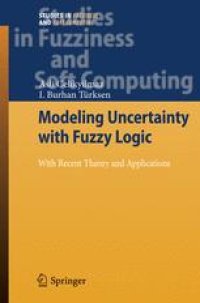
Ebook: Modeling Uncertainty with Fuzzy Logic: With Recent Theory and Applications
- Tags: Appl.Mathematics/Computational Methods of Engineering, Artificial Intelligence (incl. Robotics)
- Series: Studies in Fuzziness and Soft Computing 240
- Year: 2009
- Publisher: Springer-Verlag Berlin Heidelberg
- Edition: 1
- Language: English
- pdf
The objective of this book is to present an uncertainty modeling approach using a new type of fuzzy system model via "Fuzzy Functions". Since most researchers on fuzzy systems are more familiar with the standard fuzzy rule bases and their inference system structures, many standard tools of fuzzy system modeling approaches are reviewed to demonstrate the novelty of the structurally different fuzzy functions, before we introduced the new methodologies. To make the discussions more accessible, no special fuzzy logic and system modeling knowledge is assumed. Therefore, the book itself may be a reference for some related methodologies to most researchers on fuzzy systems analyses. For those readers, who have knowledge of essential fuzzy theories, Chapter 1, 2 should be treated as a review material. Advanced readers ought to be able to read chapters 3, 4 and 5 directly, where proposed methods are presented. Chapter 6 demonstrates experiments conducted on various datasets.
The objective of this book is to present an uncertainty modeling approach using a new type of fuzzy system model via "Fuzzy Functions". Since most researchers on fuzzy systems are more familiar with the standard fuzzy rule bases and their inference system structures, many standard tools of fuzzy system modeling approaches are reviewed to demonstrate the novelty of the structurally different fuzzy functions, before we introduced the new methodologies. To make the discussions more accessible, no special fuzzy logic and system modeling knowledge is assumed. Therefore, the book itself may be a reference for some related methodologies to most researchers on fuzzy systems analyses. For those readers, who have knowledge of essential fuzzy theories, Chapter 1, 2 should be treated as a review material. Advanced readers ought to be able to read chapters 3, 4 and 5 directly, where proposed methods are presented. Chapter 6 demonstrates experiments conducted on various datasets.
The objective of this book is to present an uncertainty modeling approach using a new type of fuzzy system model via "Fuzzy Functions". Since most researchers on fuzzy systems are more familiar with the standard fuzzy rule bases and their inference system structures, many standard tools of fuzzy system modeling approaches are reviewed to demonstrate the novelty of the structurally different fuzzy functions, before we introduced the new methodologies. To make the discussions more accessible, no special fuzzy logic and system modeling knowledge is assumed. Therefore, the book itself may be a reference for some related methodologies to most researchers on fuzzy systems analyses. For those readers, who have knowledge of essential fuzzy theories, Chapter 1, 2 should be treated as a review material. Advanced readers ought to be able to read chapters 3, 4 and 5 directly, where proposed methods are presented. Chapter 6 demonstrates experiments conducted on various datasets.
Content:
Front Matter....Pages -
Introduction....Pages 1-10
Fuzzy Sets and Systems....Pages 11-50
Improved Fuzzy Clustering....Pages 51-104
Fuzzy Functions Approach....Pages 105-147
Modeling Uncertainty with Improved Fuzzy Functions....Pages 149-215
Experiments....Pages 217-304
Conclusions and Future Work....Pages 305-311
Back Matter....Pages -
The objective of this book is to present an uncertainty modeling approach using a new type of fuzzy system model via "Fuzzy Functions". Since most researchers on fuzzy systems are more familiar with the standard fuzzy rule bases and their inference system structures, many standard tools of fuzzy system modeling approaches are reviewed to demonstrate the novelty of the structurally different fuzzy functions, before we introduced the new methodologies. To make the discussions more accessible, no special fuzzy logic and system modeling knowledge is assumed. Therefore, the book itself may be a reference for some related methodologies to most researchers on fuzzy systems analyses. For those readers, who have knowledge of essential fuzzy theories, Chapter 1, 2 should be treated as a review material. Advanced readers ought to be able to read chapters 3, 4 and 5 directly, where proposed methods are presented. Chapter 6 demonstrates experiments conducted on various datasets.
Content:
Front Matter....Pages -
Introduction....Pages 1-10
Fuzzy Sets and Systems....Pages 11-50
Improved Fuzzy Clustering....Pages 51-104
Fuzzy Functions Approach....Pages 105-147
Modeling Uncertainty with Improved Fuzzy Functions....Pages 149-215
Experiments....Pages 217-304
Conclusions and Future Work....Pages 305-311
Back Matter....Pages -
....